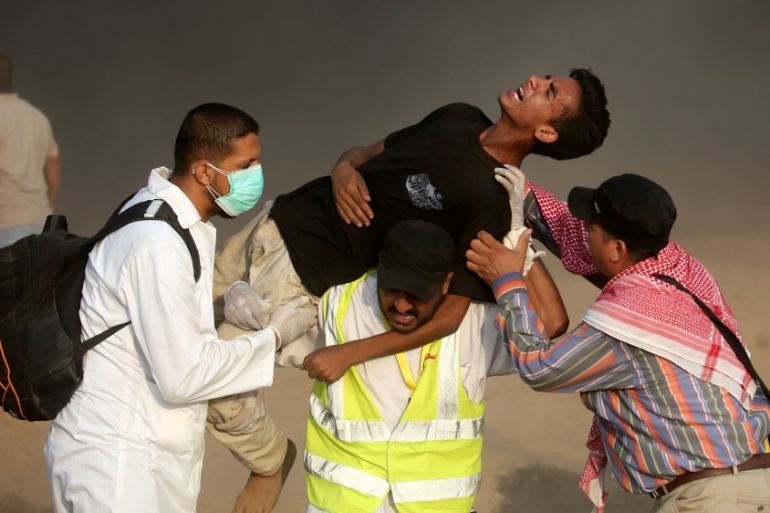The past six months in Gaza have been like another war
I am a doctor in Gaza and I have never seen anything like this before.

As a doctor living and working in Gaza all my life, I thought I had seen it all. I felt I knew the limits of what Gaza can endure
But the last six months have been the most difficult I have experienced in my 15 years with MSF in Gaza. And I have lived and worked through three wars: in 2008, 2012 and 2014.
Keep reading
list of 4 items‘Mama we’re dying’: Only able to hear her kids in Gaza in their final days
Europe pledges to boost aid to Sudan on unwelcome war anniversary
Birth, death, escape: Three women’s struggle through Sudan’s war
The human suffering and devastation I saw over the past few months have reached another height. The shocking volume of wounded has been overwhelming.
I will never forget Monday, May 14. In the span of 24 hours, the local health authorities recorded a total of 2,271 wounded, including 1,359 people injured by live ammunition. I was on shift that day with the surgical team of al-Aqsa hospital, one of the main hospitals in Gaza.
At 3pm we started receiving the first wounded from the demonstration. More than 300 arrived though the doors in less than four hours. I had never seen so many patients in my life.
Hundreds were lining up to get into the operating theatre; the corridors were full; everyone was crying, shouting and bleeding.
No matter how hard we worked, we could not cope with the huge number of injured. It was too much. Gunshot after gunshot, our team worked for 50 hours straight trying to save lives.
It brought back the memories of the 2014 war. But really, nothing could have prepared us for what we saw on May 14. And what we are still seeing today.
Each week new trauma cases continue to arrive, the majority of them young men with gunshot wounds to their legs with high risk of life-changing disabilities. MSF’s cohort of patients continues to grow and right now we are treating about 40 percent of all those wounded by gunshots in Gaza, who are over 5,000 people.
But the more we advance in treating these gunshot injuries, the more we see the complexity of what has to be done. It’s difficult, medically and logistically. The medical structures in Gaza are crumbling under the high demand for health services and ongoing shortages; a large proportion of the patients need specialised limb reconstructive surgical intervention, which means multiple surgeries. Some of these procedures are not currently possible in Gaza.
What terrifies me the most is the risk of infection. Osteomyelitis is a deep infection of the bone. If it goes untreated, it can lead to wounds that do not heal and increase the risk of amputation. These infections need to be treated urgently because they worsen quickly if medication is not introduced.
But the infection is not easy to diagnose and there is currently no structure in Gaza for analysing bone samples to identify it. MSF is working to set up a microbiology laboratory here, providing supplies and training, in order to be able to test bone samples for osteomyelitis. But once we are able to identify the infection, treatment requires a long and complex course of anti-biotics for each patient and repeated surgical intervention.
As a doctor, I travel all over the Gaza strip and I see more and more young men on crutches with external fixators on their legs or in wheelchairs. It’s increasingly becoming a normal sight. Many of them try to be hopeful and persevere, but I, as a doctor, know that their future is bleak.
One of the most difficult things in my work is having to talk to patients, most of them young men, knowing that they could lose their leg as a result of a bullet that has shattered their bones and future. Many of them ask me “Will I be able to walk freely again?”
Facing this question is very hard for me because I know that due to the situation we are working in, many of them will not be able to walk normally again. And it is my responsibility to tell them that we are doing our best, but the risk of them losing the injured leg is high.
To tell this to a young man with his life ahead of him is really difficult. And it’s a conversation I have had to have many times in recent months.
Of course, we continue to try to find a way to treat these people despite the hardships we face: overwhelmed hospitals and, because of the blockade, four hours of electricity a day, fuel shortages, depleted medical supplies, a lack of specialist surgeons and doctors, exhausted nurses and medics who have not being paid their full salaries for months on end, restrictions on patients leaving Gaza to receive medical treatment elsewhere and the list goes on.
This, while the socioeconomic situation around us continues to deteriorate on a daily basis. Now we see children begging in the street – something we never saw a year or two ago.
MSF is facing huge challenges and we cannot do it alone. We try. We push. We have to keep going. For me, it’s a question of medical ethics. These injured people must get the treatment they need.
Right now in Gaza, looking into the future is like looking into a dark tunnel and I’m not sure I can see a light at the end of it.
The views expressed in this article are the author’s own and do not necessarily reflect Al Jazeera’s editorial stance.
